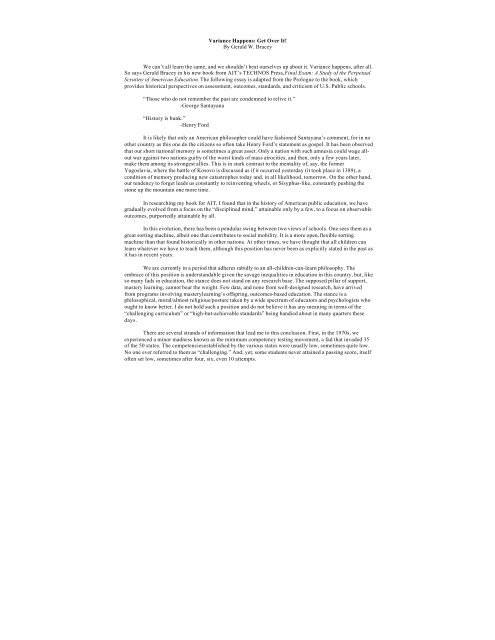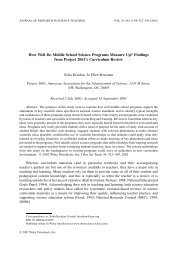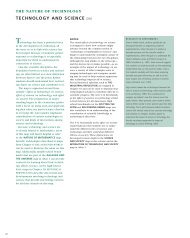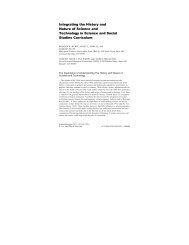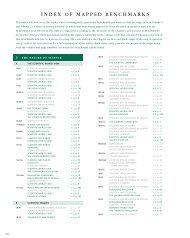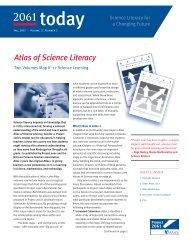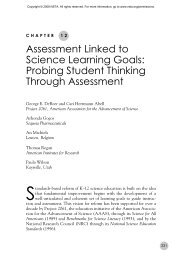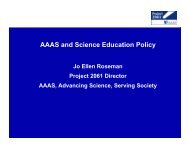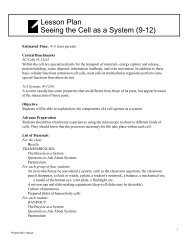Variance Happens: Get Over It! By Gerald W. Bracey ... - Project 2061
Variance Happens: Get Over It! By Gerald W. Bracey ... - Project 2061
Variance Happens: Get Over It! By Gerald W. Bracey ... - Project 2061
You also want an ePaper? Increase the reach of your titles
YUMPU automatically turns print PDFs into web optimized ePapers that Google loves.
<strong>Variance</strong> <strong>Happens</strong>: <strong>Get</strong> <strong>Over</strong> <strong>It</strong>!<br />
<strong>By</strong> <strong>Gerald</strong> W. <strong>Bracey</strong><br />
We can’t all learn the same, and we shouldn’t beat ourselves up about it. <strong>Variance</strong> happens, after all.<br />
So says <strong>Gerald</strong> <strong>Bracey</strong> in his new book from AIT’s TECHNOS Press, Final Exam: A Study of the Perpetual<br />
Scrutiny of American Education. The following essay is adapted from the Prologue to the book, which<br />
provides historical perspectives on assessment, outcomes, standards, and criticism of U.S. Public schools.<br />
“Those who do not remember the past are condemned to relive it.”<br />
-George Santayana<br />
“History is bunk.”<br />
-Henry Ford<br />
<strong>It</strong> is likely that only an American philosopher could have fashioned Santayana’s comment, for in no<br />
other country as this one do the citizens so often take Henry Ford’s statement as gospel. <strong>It</strong> has been observed<br />
that our short national memory is sometimes a great asset. Only a nation with such amnesia could wage allout<br />
war against two nations guilty of the worst kinds of mass atrocities, and then, only a few years later,<br />
make them among its strongest allies. This is in stark contrast to the mentality of, say, the former<br />
Yugoslavia, where the battle of Kosovo is discussed as if it occurred yesterday (it took place in 1389), a<br />
condition of memory producing new catastrophes today and, in all likelihood, tomorrow. On the other hand,<br />
our tendency to forget leads us constantly to reinventing wheels, or Sisyphus-like, constantly pushing the<br />
stone up the mountain one more time.<br />
In researching my book for AIT, I found that in the history of American public education, we have<br />
gradually evolved from a focus on the “disciplined mind,” attainable only by a few, to a focus on observable<br />
outcomes, purportedly attainable by all.<br />
In this evolution, there has been a pendular swing between two views of schools. One sees them as a<br />
great sorting machine, albeit one that contributes to social mobility. <strong>It</strong> is a more open, flexible sorting<br />
machine than that found historically in other nations. At other times, we have thought that all children can<br />
learn whatever we have to teach them, although this position has never been as explicitly stated in the past as<br />
it has in recent years.<br />
We are currently in a period that adheres rabidly to an all-children-can-learn philosophy. The<br />
embrace of this position is understandable given the savage inequalities in education in this country, but, like<br />
so many fads in education, the stance does not stand on any research base. The supposed pillar of support,<br />
mastery learning, cannot bear the weight. Few data, and none from well-designed research, have arrived<br />
from programs involving mastery learning’s offspring, outcomes-based education. The stance is a<br />
philosophical, moral/almost religious/posture taken by a wide spectrum of educators and psychologists who<br />
ought to know better. I do not hold such a position and do not believe it has any meaning in terms of the<br />
“challenging curriculum” or “high-but-achievable standards” being bandied about in many quarters these<br />
days.<br />
There are several strands of information that lead me to this conclusion. First, in the 1970s, we<br />
experienced a minor madness known as the minimum competency testing movement, a fad that invaded 35<br />
of the 50 states. The competencies established by the various states were usually low, sometimes quite low.<br />
No one ever referred to them as “challenging.” And, yet, some students never attained a passing score, itself<br />
often set low, sometimes after four, six, even 10 attempts.
Related to this outcome is my second reason: to paraphrase the popular bumper sticker, variance<br />
happens. <strong>It</strong> happens even in Japan, a nation that worships homogeneity and makes every attempt to reduce<br />
the variance of many variables, including test scores, to zero. I have heard many times that by high school<br />
age, 80 percent of the students cannot understand the difficult mathematics they are taught. A recent article,<br />
“Japanese Education: The Myths and Realities,” suggests that these stories have some substance. The article<br />
is by Kazuo Ishizaka, a member of the Japanese National Institute of Educational Research, and a former<br />
principal and mathematics teacher. Ishizaka declares that in some Japanese high schools, the average on a<br />
national mathematics test where the highest score is 100, will be about 96 or 98. In his school it was 5. He<br />
wonders why his school was never asked to participate in international studies. (The same paper contains a<br />
scandalous revelation that for the 1987 Second International Mathematics Study, in which Japan finished<br />
first, only schools that scored well above average on a Japanese-made test were selected [Ishizaka, 1994].)<br />
The schools of our “competitor nations” are sometimes described as if they are monolithically good,<br />
but variance-enormous variance-happens in them. For instance, consider Taiwan, whose eighth graders<br />
finished first in math in the Second International Assessment of Educational Progress released in 1992.<br />
While the average score in Taiwan bested everyone else, the 95th percentile was even higher, relatively<br />
speaking, than other high-scoring nations. The 5th percentile, on the other hand, was much lower than the<br />
5th percentile of numerous countries with only slightly lower averages. Does it even make sense, then, to<br />
speak of “Taiwanese schools” or “American schools” on the basis of average scores? I think not. Does it<br />
make sense, then, to say that in all countries some children will not learn? I think so.<br />
See How They Run<br />
If we were to use an image other than educational, we might more readily see the folly of our<br />
position: “All children can run.” Obviously, this is not true. Some children have no useful legs nor can they<br />
propel a wheelchair in any way that might be considered a proxy for running. The great majority of students<br />
can “run,” of course, but the difference in running speeds will be enormous. Anyone who thinks back on<br />
participation in school athletics will recall that running times varied enormously even among those<br />
sufficiently proficient to play on a varsity team. If the “high-but-achievable standard” was to have all<br />
children be able to run a mile, but to wait for the slowest to finish before moving beyond this point, it would<br />
be necessary for the faster children to spend a lot of time not running.<br />
This is one of the major objections voiced by some to outcomes-based education (OBE) programs,<br />
although the promoters of OBE deny that it is a necessary characteristic of the program. The alternative to<br />
holding the faster runners in check for some time is to allow them to keep on running. This, of course,<br />
increases their advantage over the slower runners in terms of distance traversed in a given amount of time.<br />
Despite the denials of OBE promoters, this happens in both mastery learning and in OBE programs, even in<br />
the programs described by OBE’s leading sponsor, William Spady, founder of the High Success Network,<br />
Inc.<br />
Spady refers to “having the faster learners engage in challenging extension and enrichment<br />
activities” and “stimulating projects and exercises” while the slower students “master the initial material.”<br />
Such enrichment activities increase the initial advantage of the faster learners. Spady would prefer<br />
continuous progress programs, where each student moves as his progress permits, but in such programs the<br />
distance between fast learners and slow ones will be increased even more. Such programs would exacerbate<br />
the differences between the “cognitive elite” and the rest. In the 1970s, for example, most students passed a<br />
minimum competency test at first sitting and were free to move on. For some students, though, the material<br />
covered by the minimum competency tests became the curriculum.<br />
2
One could object that our educational programs have never been designed to optimize the learning<br />
of all students and that maybe we now know enough to effect such optimization with the result that all<br />
children “learn.” But when we look at some programs that would appear to enhance, if not optimize, such<br />
learning, we find enormous variance still. These results can be seen in data from Reading Recovery and<br />
Success For All, two compensatory programs that are probably the most effective in the nation. The<br />
programs differ somewhat, but both would be called “intensive,” using as they do substantial amounts of<br />
one-on-one tutoring. They also seem based on sound theoretical principles and reflect the good sense of<br />
practitioners as well. Under the tutelage of these programs, many students do indeed improve their reading<br />
scores substantially, a sufficient reason for both programs to enjoy expansion in the nation.<br />
But some children do not improve much and some not at all. This is true even in Reading Recovery,<br />
where the criterion for treatment termination is often quite modest. Children are considered to have<br />
successfully completed the program when they attain the average reading score of their class. In some urban<br />
settings, this average itself is not very high, certainly nowhere near “grade level”. In both programs, some<br />
students remain hard-core non-readers.<br />
A third reason is that society will not-cannot-permit all children to learn. I outlined some reasons<br />
why in a short Education Week essay, What If Education Broke Out All <strong>Over</strong>? (March 28, 1994). There I<br />
argued that if everyone learned, society would collapse, literally. I do not know if education so refines the<br />
senses or simply makes people allergic to sweat, but educated people will not collect garbage, unclog<br />
sewers, scour urinals, make up beds, bus tables, etc.<br />
Workplace Predictions and Other Modern Myths.<br />
A current myth holds that the new jobs being created are all high-skill, high-tech. This is not true.<br />
While the implication of the myth is that schools must do more for more people, the Bureau of Labor<br />
Statistics 1991 list of the 10 fastest-growing jobs between 1990 and 2005 shows them to require some skills,<br />
but not to be necessarily high-tech. Even the Hudson Institute’s 1988 report, Workforce 2000, considered by<br />
many to be the clarion call for a more highly skilled workforce, found that the to-be-created jobs only<br />
required eight more months of education than current jobs. Other estimates put the figure at four months.<br />
Either way, meeting these changing job demands poses no severe national challenge.<br />
The educational differentials between those entering the workforce and those retiring are sufficiently<br />
great to more than overcome the needed extra schooling. People retiring from the workforce in 1995 at age<br />
65 (assuming that their pensions haven’t disappeared), would have graduated from high school in 1948<br />
when the chances were about 50-50 that they would have graduated at all. Currently, 83 percent of high<br />
school students receive an on-time diploma, another four percent return to obtain one, and another four<br />
percent attain a GED.<br />
In addition, the fastest growing jobs account for very few, the new high-tech jobs for even fewer. On<br />
the other hand, the single top job in terms of numbers, retail sales, accounts for one-third more jobs than the<br />
top 10 fastest growing jobs combined, 4.5 million versus 3.2 million. Even Secretary of Labor Robert Reich,<br />
who has written glib pieces with glib titles such as “Workers of the World <strong>Get</strong> Smart,” has admitted that no<br />
nation has solved the problem of creating both more jobs and good jobs. There is also mounting evidence<br />
that the good jobs are declining in number. In 1992, for instance, manufacturing lost 255,000 jobs. The<br />
restaurant industry alone added 249,000 in that year. Not many of those jobs were for executive chefs.<br />
Indeed, the call to “make work smart,” perhaps the economic equivalent of “all children can learn,”<br />
seems to have led us in a wrong direction. The arguments for making work smart were first described in the<br />
Center on Education and The Economy’s 1990 treatise, America’s Choice: High Skills or Low Wages. A<br />
1992 follow-up book, Thinking for a Living, by the Center’s director, Marc Tucker, and former Secretary of<br />
3
Labor Ray Marshall, expanded the notion of making work smart while it also expanded their claims for the<br />
wonders it would accomplish. They said making work smart was a recipe not only for high wages but also<br />
for full employment. Look at Europe, they said.<br />
Yes, look at Europe and find 12 percent unemployment, 20 percent in some quarters, 50 percent<br />
among some immigrant groups. Find Germany, already with the shortest work weeks and longest vacations<br />
in Europe, thinking about trimming the work week further. Find France tinkering with the notions of job<br />
sharing and cutting the minimum wage to get more people employed. An appropriate book to reflect the<br />
situation both here and abroad might be titled America’s Choice: High Skills and Low Wages.<br />
In his 1992 book, The Culture of Contentment, Harvard economist John Kenneth Galbraith gave a<br />
name to the children who do not learn, to the low-paid, unskilled workers: “the functional underclass.”<br />
According to Galbraith, we gloss over the dreary duties of the underclass by lumping all activities under the<br />
word “work” and then glorifying the word. But much work is intrinsically meaningless, repetitive, boring,<br />
even dangerous. Galbraith declares that the word “work” is used to cloak the fact that some people’s jobs<br />
require activity that is “dreary, painful or socially demeaning and for others is enjoyable, socially reputable<br />
and economically rewarding.”<br />
The “working poor” will always be with us. They are not a social problem to eliminate, says<br />
Galbraith. “The poor in our economy are needed to do the work that the more fortunate do not do and would<br />
find distasteful, even distressing. And a continuing supply and re-supply of such workers is always needed,”<br />
because the children of such workers and the workers themselves seek to escape such demeaning conditions.<br />
In theory, such as that promulgated by behaviorist B.F. Skinner, you could entice the cognitive elite<br />
to sweep streets by paying them more. In practice, it has never worked out that way. When a few countries<br />
have actually gotten to a point where almost everyone has learned, the solution to the shortage of dirty-work<br />
workers has been to import undereducated workers or workers from underdeveloped nations. Whether or not<br />
some groups of Americans have come to form a permanent underclass is a matter of some debate, but as a<br />
nation of immigrants, we are relieved of the solutions forced on other nations. Although our solution is<br />
functionally equivalent, the imported workers here do have the option of becoming citizens, something not<br />
afforded those or their children in most other countries.<br />
But we refuse to see the sight that Galbraith insists we look on: What is not accepted, and indeed is<br />
little mentioned [by the comfortable classes], is that the underclass is integrally a part of a larger economic<br />
process and, more importantly, that it serves the living standard and the comfort of the more favored<br />
community. The economically fortunate, not excluding those who speak with greatest regret of the existence<br />
of this class, are heavily dependent on its presence.<br />
They Set Us Up<br />
So it is that, while we say everyone can learn and we want to educate everyone, the unyielding facts<br />
are that they cannot and we do not. This is not merely an unkind blow to our egalitarian impulse. <strong>It</strong> also sets<br />
up educators for a great fall. <strong>By</strong> telling everyone that all children can learn, we set the stage for the next<br />
great round of educational failure when it is revealed that not everyone has learned, in spite of our sincere<br />
beliefs and improved practices.<br />
At this moment, articles being written about the schools include comments like the following from<br />
the April 17, 1995, issue of Business Week, whose cover asks “Will Schools Ever <strong>Get</strong> Better?” The opening<br />
paragraph recounts in brief the usual litany of complaints, but in stronger terms than usual.<br />
4
Americans are fed up with their public schools. Businesses complain that too many job applicants<br />
can’t read, write, or do simple arithmetic. Parents fear that the schools have become violent cesspools where<br />
gangs run amok and that teachers are more concerned with their pensions than their classrooms.<br />
Economists fret that a weak school system is hurting the ability of the [United States] to compete in<br />
the global economy. And despite modest improvements in test scores, U.S. students rank far behind most of<br />
their international peers in science and math.<br />
None of these statements is true, but one can imagine what Business Week might write after another<br />
decade of “ineffectual” reform or even reform that showed improvement, but not enough. After all, in 10<br />
years it will be almost a quarter century since the appearance of “A Nation At Risk.”<br />
Of course, one response to the above is that we will have a decade of effectual reform. I doubt it. Or<br />
rather, in spite of what I view as a century of almost continuous progress, I doubt that we can effect the<br />
kinds of reforms that would satisfy critics. Indeed, I argue in Section 4 of my book that the well-intentioned<br />
standards movement itself will increase the disparities among the cognitive haves and have-nots.<br />
Many other educational trends will produce, are producing, similar effects. For instance, the<br />
proportion of affluent students in preschool is much higher than the proportion of poor children in preschool.<br />
And the programs offered the rich tend to be developmental, even academic, while the poor often obtain<br />
only custodial care. This condition moves us farther from, not closer to, the first National Education Goal,<br />
that all children arrive at school ready to learn. At the same time, new technologies are increasingly being<br />
used for learning activities. And such machines are to be found much more commonly in the homes of the<br />
affluent.<br />
Our notion that we constitute an egalitarian nation received a mighty shock in April 1995, when The<br />
New York Times reported on a new study showing that we are the most stratified nation in the western<br />
world. In England, a nation we often associate with a rigid class structure and centralized control of wealth,<br />
the top one percent of households control 19 percent of the wealth. In the United States, they control 40<br />
percent, up from 20 percent in 1980. The top 20 percent of households control 80 percent of the wealth. The<br />
bottom 20 percent of households earn only 5 percent of the income in this nation.<br />
“World Class” or Third World?<br />
None of this is to say that many children could learn much more than they presently do; they could.<br />
But if we predicate reform on unrealistic assumptions, not only do we set the stage for inevitable failure, we<br />
are prevented from seeing the present conditions as they really are. The unremitting criticism of American<br />
public schools abundant since their inception, but overwhelming since the end of World War II has led to<br />
such misperceptions. For instance, in the Second International Assessment of Educational Progress (IAEP)<br />
of 1992, Taiwanese and Korean 13-year-olds had the highest scores in math. However, it was determined<br />
that Asian students in American schools outscored both countries. Hungary finished third among nations,<br />
and white students in U.S. schools tied Hungary. Thus a large majority of American students the two groups<br />
constitute about 70 percent of the current K-12 population do quite well compared to their Asian and<br />
European peers.<br />
In this same study, however, while Mississippi and Jordan tied for last place, Black, Hispanic, and<br />
disadvantaged urban students all scored below them. (There is no IAEP reporting category for disadvantaged<br />
rural; were there, I would predict that that group would score lower still.) <strong>It</strong> is thus the case that many<br />
American students are “world class” even in math, where we are such putative dolts but some aren’t even<br />
Third World. We are in a better state than thought overall, but, given the concentration of wealth noted<br />
above, are we likely to find that it is distributed to assist school systems that need it? Only if still more<br />
5
school finance systems are declared by state supreme courts to be unconstitutional, or if more states show<br />
the progressive tendency of Minnesota and Michigan and look to move voluntarily toward shifting school<br />
funding away from the inevitable inequitable property tax base.<br />
Excellent and Equitable<br />
My book paints a picture of a system that has painted itself into a corner. There is a potential way<br />
out, but it involves taking a path that we have not been good at following in the past. In his 1961 book by the<br />
same name, John Gardner asked, “Can we be excellent and equal, too?” The answer is clearly ”no” if by<br />
equal is meant the same. Different students will emerge from school knowing different things as well as<br />
different amounts of the same things. But, we could ask, can we be equitable and excellent at the same time?<br />
If we look to another Gardner, Howard, we find a theory of multiple intelligences that demands that people<br />
be different (Frames of Mind, 1983). Historically, we have not been good at saying that people are different<br />
but not unequal. To say that two outcomes are different through our history has been to imply that one of<br />
them is inferior. About 60 percent of U.S. high school graduates go to college, although (historically) no<br />
more than 25 to 30 percent of them obtain college degrees. Thus, it would seem, almost half of our students<br />
need something other than a college preparatory curriculum. But when a proposal is made for, say, an<br />
apprenticeship system patterned after that found in Germany, many people recoil, knowing that such a<br />
system puts limits on the future (in fact, more and more German students are recoiling for the same reason).<br />
At the same time as people recoil from differential outcomes, they recoil from any attempt at<br />
perceived standardization. One of the chief criticisms of outcomes based education is that it denies<br />
individuality and tries to mass-produce everyone the same. The confusion between standards and<br />
standardization is rife in American education, as it is in American life overall.<br />
<strong>Get</strong>ting out of the corner will not be easy, but I hold in my book that focusing on the outcomes of<br />
education requires us to try. As long as equal education is defined in terms of inputs and processes,<br />
inequalities of outcomes are tolerable. When the focus is on outcomes, inequalities become, at best, painful<br />
to see.<br />
I hope that my book will provide a historical perspective from which policy and programs may be<br />
developed. <strong>It</strong> is my fervent belief that Santayana was right when he wrote, “Those who do not remember the<br />
past are condemned to relive it.” Thus, in bringing some sense of history to the current enterprises, I hope to<br />
provide useful context.<br />
In addition, I hope the histories I write about will debunk once and for all the notion abroad in some<br />
quarters that there was once a Golden Age of American education from which state we have fallen and must<br />
strive to return. Truly, this, to cite Henry Ford, is “bunk.” In the first section of my book, I provide a<br />
selective history of education in this nation, focusing on the always abundant criticism of public schools and<br />
the attempts to reform them, especially at the attempts made after the Committee of Ten’s efforts a century<br />
ago. People interested in seeing the data that prove the critics wrong are referred to “The <strong>Bracey</strong> Report on<br />
the Condition of Public Education,” which has appeared each October since 1991 in Phi Delta Kappan<br />
magazine; to my earlier book, Transforming America’s Schools, published by the American Association of<br />
School Administrators (AASA) in 1994; to David Berliner’s The Manufactured Crisis, (Addison-Wesley,<br />
1995); or to Joseph Schneider’s and Paul Houston’s Exploding the Myths (AASA).<br />
We are currently embroiled in many discussions about “authentic assessment,” standards, and<br />
outcomes. These, too, are discussions lacking much in the way of historical setting. To understand what<br />
schools are and have been about, though, it seems to me that we should understand the history of outcomes<br />
and standards and of how those outcomes and standards would be assessed. These histories all show<br />
6
evolving meanings of outcomes, standards, and assessments and constitute the other three major sections of<br />
my TECHNOS Press book.<br />
Even Greater Expectations<br />
Some who have read these histories have commented that “we have played this song before” and<br />
indeed we have. This leaves the history of education with a sense of being unplanned and, in many ways, it<br />
has been. On a more narrow scale, Robert Slavin of Johns Hopkins University has observed that educational<br />
innovations arrive amidst much hoopla and no supporting data. They then exit as the data, usually<br />
disappointing in comparison to the claims, arrive. One might hope that, by developing a sense of what has<br />
and has not been thought about schools throughout our history, we might embark on a more planned journey<br />
into the future.<br />
In addition, there are many in education now who have not lived through the modern era of reform,<br />
which I date from the end of World War II. Since then, schools have been seen as chronic failures, albeit for<br />
very different reasons across the decades. One sees that society has placed every important social problem<br />
on the schoolhouse doorstep and then reacted in anger and horror when the school’s inhabitants have failed,<br />
by themselves, to solve the problem, whatever it might be. Again, for those who have not experienced the<br />
events of the last 50 years firsthand, it is hoped that the book will provide a useful context.<br />
An examination of these histories might-but only might-provide a more realistic sense of both what<br />
schools have done and what schools can do. <strong>It</strong> is clear that one reason schools have failed is that they have<br />
not lived up to society’s expectations. But my search through the history of schooling in this nation<br />
convinces me both that those expectations have often been unrealistic and that schools have come closer to<br />
meeting them than has been realized. We now all mouth the importance of high expectations for learning,<br />
but as we do so, we should recall from clinical practice the terrible anxieties and neuroses that can be<br />
generated by the imposition of unrealistic, perfectionistic expectations.<br />
Why do we have such high expectations of schools? Because they have emerged as our most<br />
important social institution aside from those that defend the land. All the more so at present. At the same<br />
time that schools are the focal point for social problems, the church and the family are in decline. Many<br />
consider politics a cesspool of corruption and self-interest. Every day brings some astonishing new tale of<br />
fraud and malfeasance in business. Schools are refuges of integrity and fair play. Many critics tell schools to<br />
concentrate on academic matters and leave social problems to other institutions, but they fail to take into<br />
account the state of those other institutions and how that state affects the schools.<br />
In addition to these reasons for assaults on schools, public schools are targets simply because they<br />
are public. They are public in ways that no other institution in this nation is public. Businesses might have to<br />
answer to stockholders according to the bottom line (although this is largely myth; stockholders exercise<br />
very little power), but the information of how business and industry conduct their affairs is proprietary.<br />
Michael Moore’s movie Roger and Me takes some liberties with historical accuracy but still vividly shows<br />
the protection from inconvenient encounters that CEOs of large corporations enjoy. For months, Moore<br />
attempts to get an audience with Roger Smith, then president of General Motors, to ask him to explain how<br />
GM could inflict so much economic devastation on Moore’s hometown of Flint, Michigan. He never<br />
succeeds. Some school principals can be forgiven for feeling pangs of envy at Smith’s fortress-like security,<br />
security that prevails in spite of, as others have shown elsewhere, Smith’s monumental incompetence.<br />
I also hope that the histories in my book will provide convincing evidence that some of the reform<br />
efforts of the past were misguided, either because schools were not failing or because the reforms were<br />
based on unsound premises. We are currently in the throes of major reform activities aimed at certain goals<br />
and using certain standards. Are these also based on unsound premises? <strong>It</strong> is often said today in defense of<br />
goals and standards that if you don’t know where you want to go, any road will take you there. The<br />
7
conclusion is that we need the goals and standards to show us the way. In the section on standards, I<br />
conclude that standards will take us away from where we want to be.<br />
Finally, along with an acceptance of Santayana’s maxim, I agree with a generalization taken from<br />
Jean Piaget. In studying epistemology, the nature of knowledge, Piaget concluded that to understand how<br />
knowledge manifests itself in adults, he had to learn how it developed in children. I believe that while<br />
knowing where you want to go is important in knowing how to get there, it is also crucial in human<br />
endeavors to know how you got where you are. Wherever you are on a map, you can set out for any other<br />
point. That is not true of human and social development. Learning some things permits the learning of<br />
others, but forecloses the learning of still others. In the human trajectory, where you can go is to some extent<br />
constrained by where you’ve been and how you got where you are. I hope my book will help provide an<br />
account of the journey of public education in America.<br />
#########<br />
<strong>Gerald</strong> <strong>Bracey</strong> is the first Distinguished Fellow of the Agency for Instructional Technology. A research<br />
psychologist, education consultant, and writer, <strong>Bracey</strong> has served as associate director of the Institute for<br />
Child Study at Indiana University; director of research and evaluation at Cherry Creek School District in<br />
Englewood, Colorado; and director of research, evaluation, and testing for the Virginia Department of<br />
Education. He was appointed Executive Director of the Alliance for Curriculum Reform in August 1995.<br />
Final Exam: A Study of the Perpetual Scrutiny of American Education is available for $24.98 (plus $4.00<br />
shipping) from AIT’s TECHNOS Press. To order, call 812/339-2203 or fill out and mail the business reply<br />
card stitched into this issue.<br />
8


